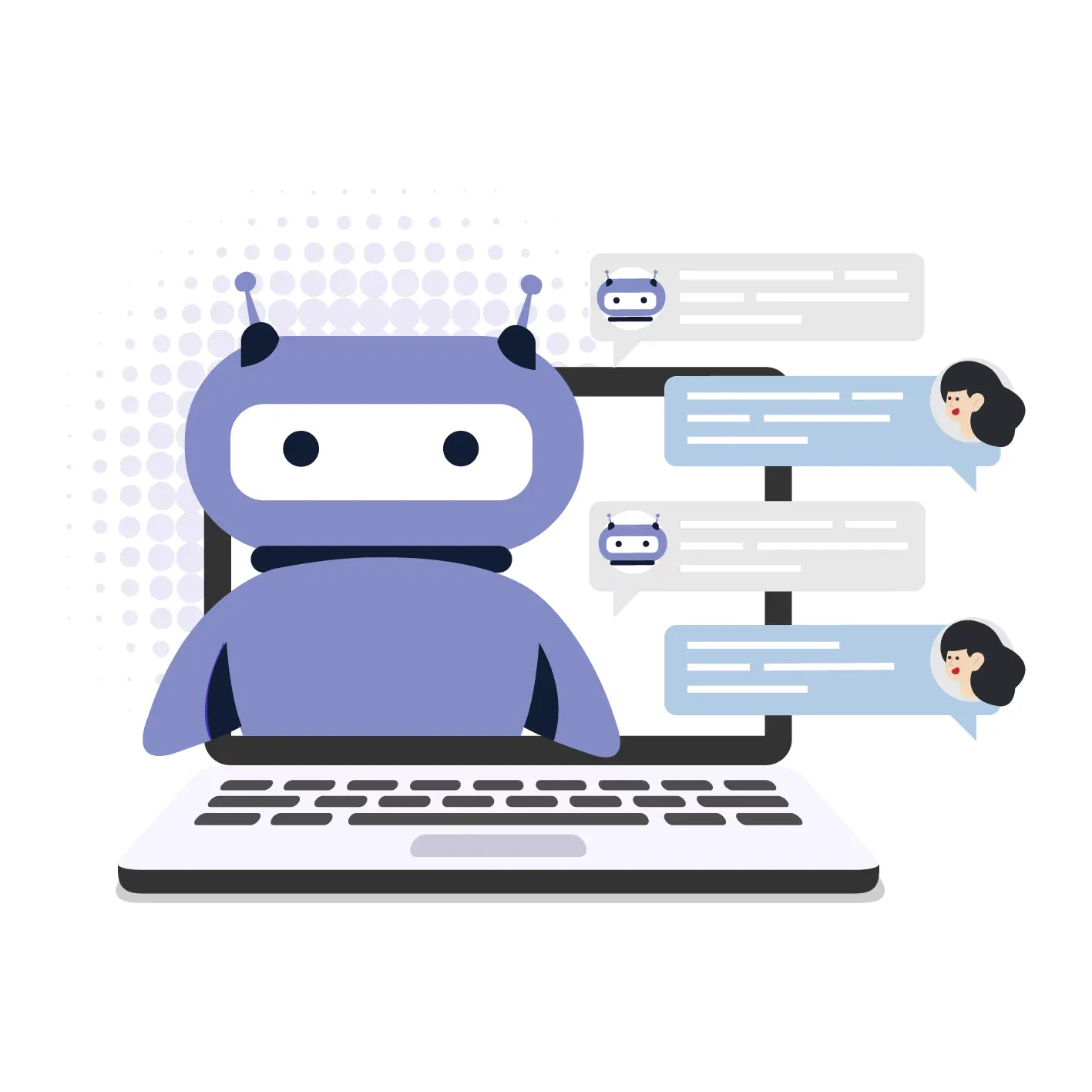What is an AI Chatbot?
Artificial intelligence chatbots simulate human conversation using computer programs. It is also known as an Assistant Bot or Virtual Assistant.
Chatbots can interact with users through text or voice. They can be programmed to answer questions, provide information, and even complete tasks .
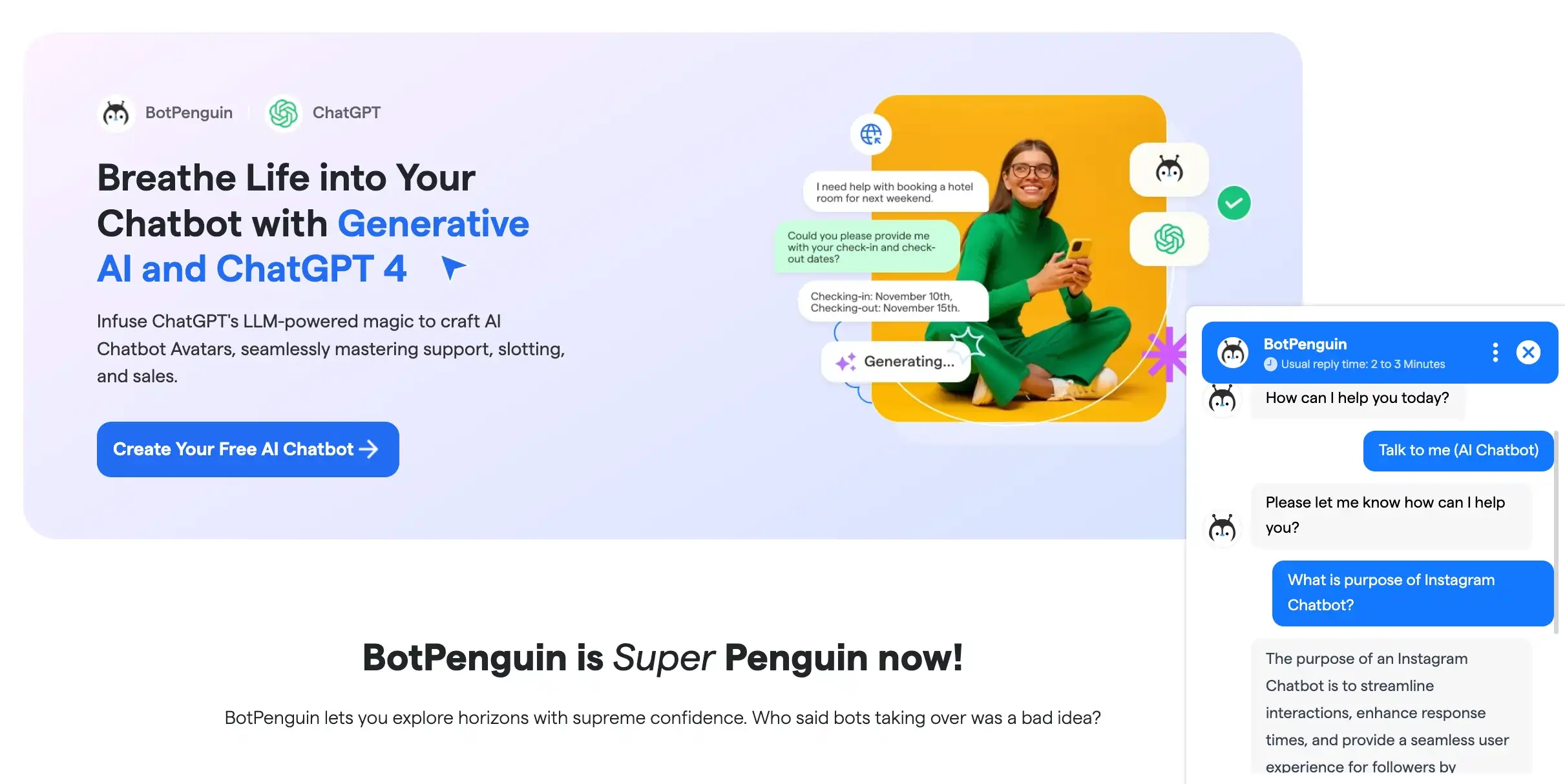
Types Of AI Chatbots
Majorly, there are two types of AI chatbots which are- Rule-based and AI- powered
Rule-Based Chatbots
Rule-based chatbots are the most basic type of chatbot. They follow pre-written rules and responses to provide information or assistance to users.
These chatbots are limited in their capabilities and cannot handle complex queries.
AI-Powered Chatbots
AI-powered chatbots are more advanced than rule-based chatbots.
They use natural language processing (NLP) and machine learning algorithms to understand the intent behind a user's message and generate appropriate responses.
These chatbots can handle more complex queries and provide personalized recommendations.
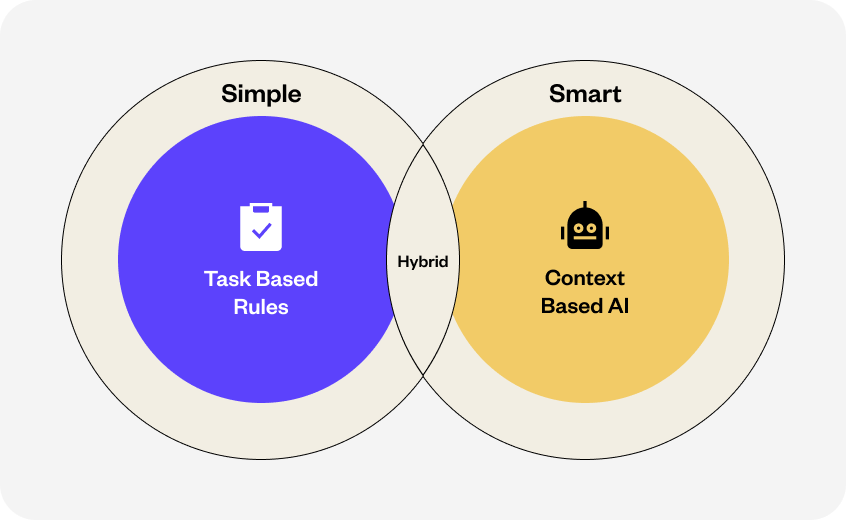
Contextual Chatbots
Contextual chatbots are designed to maintain context throughout a conversation.
They can remember previous interactions with a user and use that information to provide more personalized assistance.
These chatbots are particularly useful in customer service and support scenarios.
Voice-Enabled Chatbots
Voice-enabled chatbots use voice recognition technology to interact with users. They are commonly used in virtual assistants like Amazon's Alexa or Apple's Siri.
These chatbots require a more complex infrastructure and are more expensive to develop.
Multilingual Chatbots
Multilingual chatbots can understand and respond to multiple languages. They are particularly useful for global companies that have customers from different regions.
These chatbots require advanced language models and translation capabilities.
Why Use an AI Chatbot?
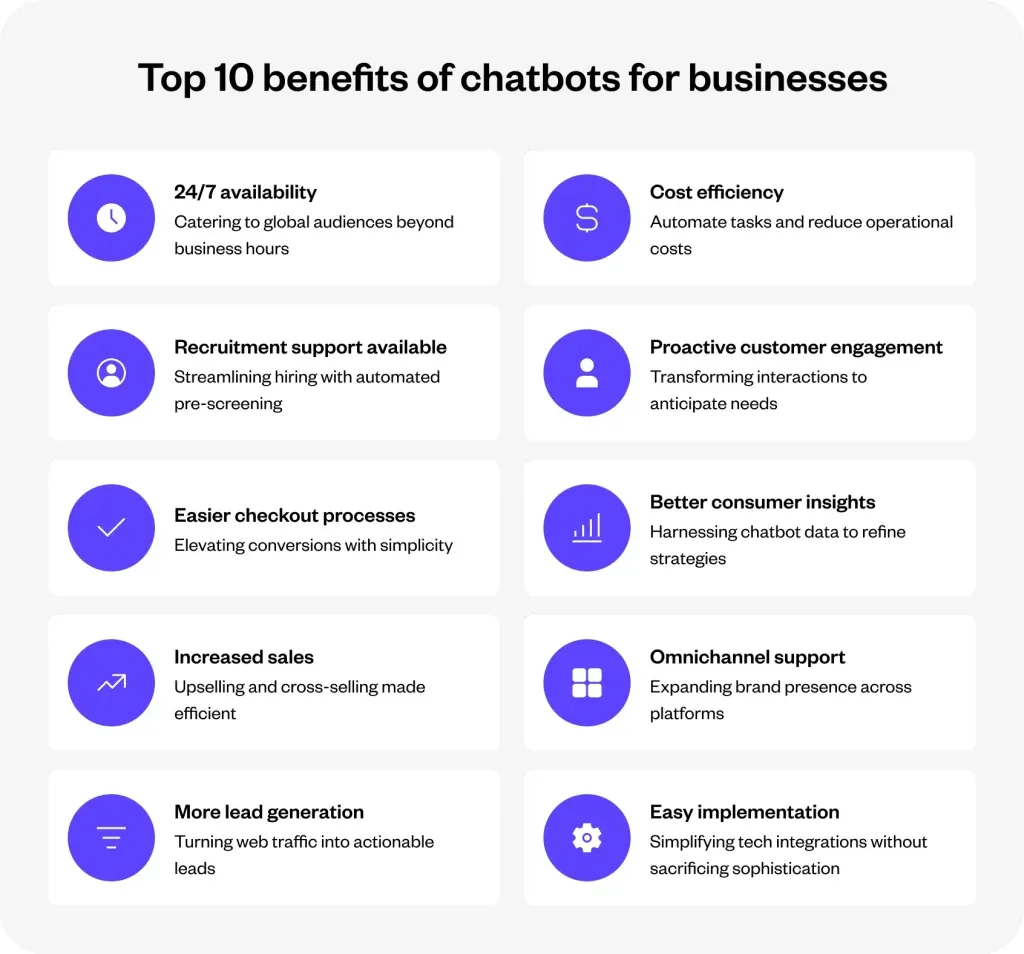
24/7 Customer Support
AI chatbots can provide 24/7 customer support without human intervention.
This means that customers can get their queries resolved at any time of the day, increasing customer satisfaction and loyalty.
Chatbots can quickly handle repetitive inquiries and respond, allowing human customer service representatives to focus on more complex or urgent issues.
Streamlined Processes
AI chatbots can help streamline processes and save time and money by automating tasks like scheduling appointments, processing orders, and answering common questions.
This reduces the workload on human employees and allows higher-value tasks. Additionally, chatbots can provide real-time updates and notifications, improving the overall efficiency of business operations.
Increased Sales Conversions
AI chatbots can help improve sales conversions by providing personalized recommendations and product suggestions based on the customer's preferences and purchase history.
Additionally, chatbots can handle the checkout process, making the process easier and faster for customers.
Real-Time Analytics and Insights
AI chatbots can provide real-time analytics and insights into customer behavior and preferences. This includes data on customer inquiries, interactions, and feedback.
By analyzing this data, businesses can gain valuable insights into customer needs and preferences, allowing them to improve their products and services to better meet customer expectations.
Cost-Effective Solution
AI chatbots can be cost-effective for businesses, especially small and medium-sized enterprises.
Implementing a chatbot is often more affordable than hiring additional customer support staff.
Additionally, chatbots can simultaneously handle a large volume of inquiries, reducing the need for additional staff during peak hours.
When to Use an AI Chatbot?
AI chatbots are most useful when there is a high volume of repetitive inquiries.
For example, a customer service chatbot could handle common questions like "What are your hours of operation?" or "How do I return a product?"
This allows human customer service representatives to focus on more complex or urgent issues.

Where Can You Use an AI Chatbot?
Website: An AI chatbot can be integrated into a website to assist visitors instantly and improve user experience.
Mobile App: AI chatbots can be used in mobile apps to provide personalized recommendations and assist users in purchasing.
Social Media: Chatbots can interact with users on platforms like Facebook, Twitter, and Instagram.
Customer Service: AI chatbots can be used in customer service to handle inquiries and support customers.
E-commerce: AI chatbots can be used in e-commerce to handle product recommendations, shopping cart management, and order tracking.
Healthcare: AI chatbots can be used in the healthcare industry to provide medical advice, schedule appointments, and monitor patients.
Education: AI chatbots can be used in education to provide personalized learning recommendations and assist students in navigating course content.
Banking: AI chatbots can be used to handle customer inquiries, provide financial advice, and monitor account activity.
Travel: AI chatbots can be used in the travel industry to handle bookings, provide travel recommendations, and offer customer support.
Human Resources: AI chatbots can be used in human resources to handle employee inquiries, provide benefits information, and streamline HR processes.
How Do AI Chatbots Work?
AI chatbots use natural language processing (NLP) to understand and interpret the meaning behind the words a user types or speak.
When a user interacts with an AI chatbot, the algorithm analyzes the user's input to identify the intent behind the message. Based on this intent, the chatbot generates an appropriate response.
To achieve this, chatbots use machine learning algorithms and data models that are trained on thousands of conversations. This allows them to recognize patterns in user input and generate more accurate responses over time.
In addition to NLP, chatbots also rely on APIs and integrations to access data from external sources in real time. For instance, a chatbot may use an API to access a user's order history or account details to provide personalized recommendations or assistance.
Here's an example of the Brand H&M to help you understand better.
H&M is a multinational clothing retail company known for its trendy and affordable fashion items. To improve their customer service and enhance the shopping experience, H&M has implemented an AI chatbot on their website and Facebook Messenger.

Natural Language Processing (NLP)
The H&M chatbot uses NLP to understand the intent behind a user's message. For example, if a user asks, "What's new in stock?", the chatbot will recognize that the user is looking for new clothing items.
Machine Learning Algorithms
To generate accurate responses, the H&M chatbot uses machine learning algorithms that are trained on thousands of conversations. Over time, the chatbot learns from these conversations and improves its responses based on user feedback.
APIs and Integrations
The H&M chatbot also relies on APIs and integrations to access data from external sources. For instance, if a user asks for the status of their order, the chatbot can access the order management system to provide real-time updates.
Personalization
One of the key benefits of using an AI chatbot is the ability to provide personalized recommendations and assistance. The H&M chatbot can access a user's purchase history and browsing behavior to suggest clothing items that match their style.
Best Practices For Implementing AI Chatbots
Before implementing a chatbot, businesses should define the purpose and goals of the chatbot.
Design a User-Friendly Interface
Chatbots should be designed with a user-friendly interface to ensure they are easy to use and navigate. The chatbot should have a clear, concise, conversational flow guiding users toward their desired outcome.
Additionally, businesses should consider incorporating multimedia elements like images, videos, or GIFs to make the conversation more engaging.
Program Clear and Concise Responses
Chatbots should be programmed to provide clear and concise responses to user inquiries.
Responses should be easy to understand and avoid using technical jargon or complicated language.
Additionally, chatbots should provide options for users to ask follow-up questions or clarify their inquiries if necessary.
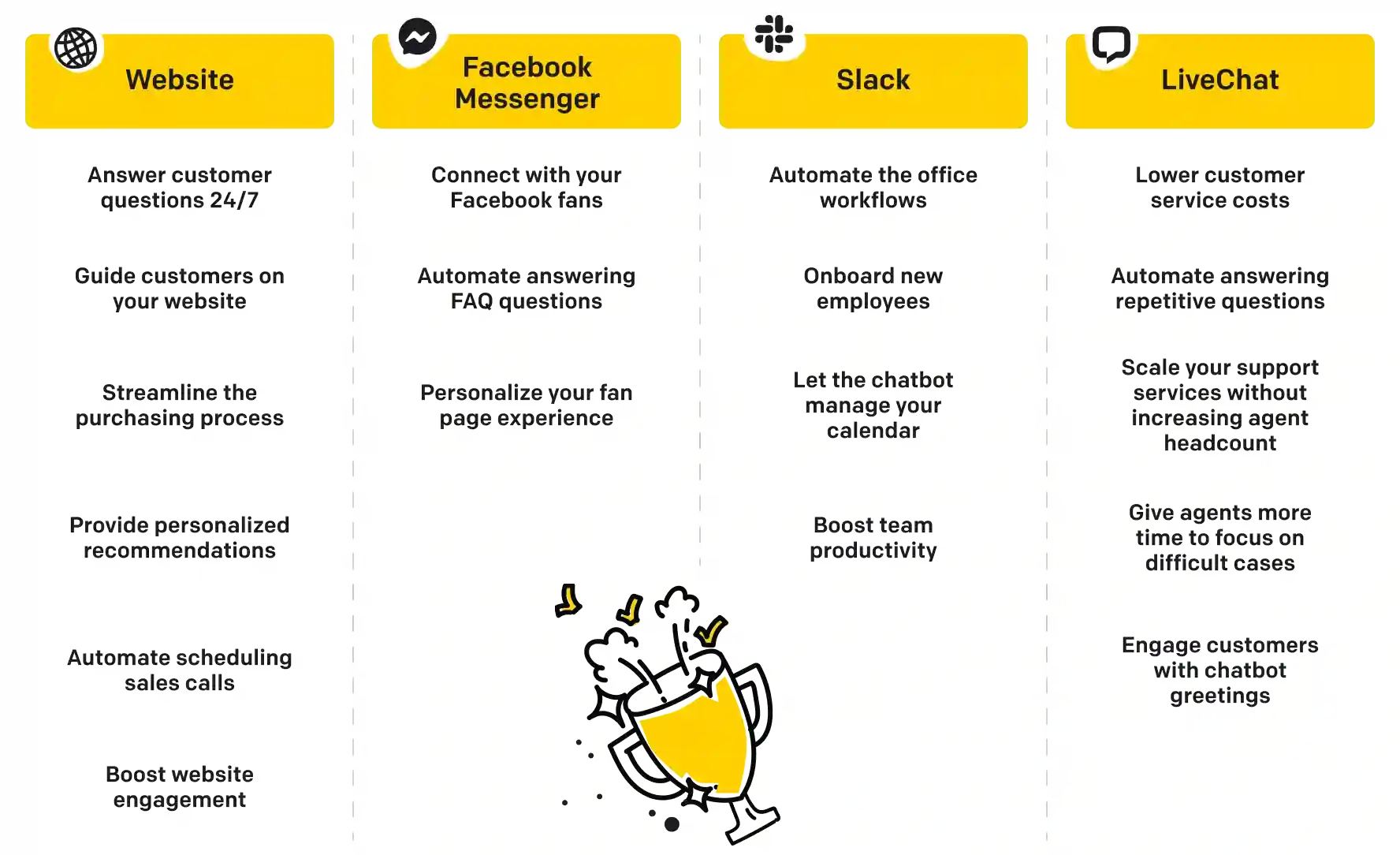
Align Chatbot Responses with Brand Voice
Businesses should consider the tone and style of their chatbot's responses to ensure they align with their brand voice.
The chatbot should reflect the personality and values of the brand to create a cohesive user experience.
Additionally, businesses should avoid using generic or robotic responses that do not align with their brand identity.
Monitor and Analyze Chatbot Performance
Businesses should regularly monitor and analyze their chatbot's performance to identify areas for improvement.
This includes tracking user interactions, analyzing user feedback, and measuring the chatbot's impact on customer satisfaction and sales conversions.
By monitoring and analyzing chatbot performance, businesses can make data-driven decisions to improve the chatbot's effectiveness over time.
Create your own AI Chatbot with BotPenguin
Frequently Asked Questions (FAQs)
What are AI chatbots, and how do they work?
AI chatbots are computer programs designed to simulate human conversation using artificial intelligence.
They use natural language processing and machine learning to understand user queries and respond with relevant information or actions.
What are the benefits of using AI chatbots for customer service?
AI chatbots can provide 24/7 customer support, improve response times, handle multiple customer inquiries simultaneously, and offer personalized experiences, leading to increased customer satisfaction and loyalty.
What is NLP and how is it used in chatbots?
NLP, or Natural Language Processing, is a field of artificial intelligence that enables computers to understand, interpret, and generate human language.
Using NLP in chatbots enables them to comprehend and respond to human language inputs, facilitating natural, conversational interactions between users and the chatbot.
What industries can benefit from AI chatbots?
AI chatbots can benefit industries such as e-commerce, healthcare, finance, and travel, where they can provide personalized recommendations, assist with purchases, schedule appointments, and handle other customer inquiries.
How can businesses create their own AI chatbots?
Businesses can create AI chatbots using chatbot development platforms such as Dialogflow, Botpress, and IBM Watson, which offer tools and resources to build, test, and deploy chatbots with natural language processing and machine learning capabilities.
What are the ethical considerations of using AI chatbots?
Ethical considerations of using AI chatbots include transparency in their use, ensuring data privacy and security, avoiding biases in their training data and algorithms, and ensuring they do not replace human jobs without providing alternative employment opportunities.
